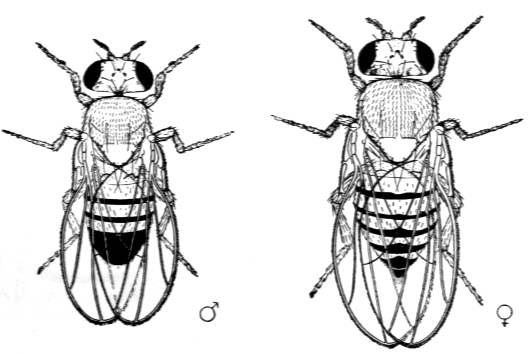Drosophila Sex
Determination: Every Cell for Itself Mechanism

Phenotypic
Consequences of Different Ratios of X
Chromosomes to Autosomes
In Drosophila n=4, where there is 1 sex chromosome and 3 autosomes.
Call each autosome set A, therefore there are 3 autosmes in a diploid fly (A=2)
Sex determination is due to the ratio of X chromosomes to the sets of autosomes (A)
Therefore:
|
XXAA
(diploid) |
X:A
ratio = 1 |
Female |
|
XYAA
(diploid) |
X:A
ratio – 0.5 |
Male |
|
XOAA
(diploid) |
X:A
ratio = 0.5 |
STERILE
Male |
|
XXXAAA
(aneuploid) |
X:A
ratio = 1 |
Female |
|
XYYAAA
(aneuploid) |
X:A
ratio = 0.33 |
Male |
|
XXYAAA
(aneuploid) |
X:A
ratio = 0.67 |
Intersex |
Regulatory
Pathway
The phenotype
is carried
out by the ‘master regulatory switch’ and downstream specific sex genes.
Sxl
gene (Sex lethal gene): choice of pathway is initiated by differential
transcription of gene as well as tra (transformer)
gene.
The direction
of the
switch is maintained by an autofeedback loop
The desistion
is
propograted along the developmental pathway by differential RNA
splicing of dsx (doublesex) gene.
The default
is a male
phenotype.
Regulatory
Switch (Sxl gene)
If X:A
ratio = 1, then SXL protein is synthesized and a phenotypically female
is the
result. If X:A ratio = 0.5, then a
non-functional SXL
protein is synthesized and a phenotypically male fly is the result.
Mechanism

The X:A
ratio set in motion the sex determination pathway by interaction
between
numerator genes ( X-chromosomal and zygotically expressed) and
denominator
genes (autosomal, maternally and zygotically expressed).
These genes
encode for
transcription factors in a basic
helix-loop-helix (bHLH): NUM, the X-encoded bHLH and DEM,
the
autosomal
encoded bHLH transcription factor.
The
transcription factors
have a very short time window, 2-3 hours of fertilization, to determine
the sex
of the individual via the Sxl gene regulatory switch.
If the gene
is turned on,
then the level of active X:A NUM
transcription factor
must be high. They bind to enhancers of Sxl
gene, activating protein transcription from the early promoter (PE)
resulting in the fully functional SXL protein.
If the gene
is turned
off, the level of NUM is lower than the threshold, and it is
insufficient to
promote transcription.
The A:X
ratio is measured by NUM proteins competing for dimmer formation with
DEM
proteins. The transcription factor is only active if NUM forms a
dimeric
protein complex.
NUM monomers
have
sequence specific DNA binding sites, DEM does not.
Binding site
recognition
enhancer sequences regulates transcript from promoter of Sxl
regulator gene switch
NUM and DEM
polypeptides
synthesized at level proportionate to number of copies of each bHLH
encoding
numerator or denominator gene
All possible
combinations
of dimmers can form, but to be active both subunits have to have
sequence
specific DNA binding sites.

Maintenance
of condition
Sxl
gene has 2 promoters, PE and PL
PE
is
activated by NUM:NUM and is active only in
early
embryogenesis
PL
promoter
transcribes the gene regardless of X:A ratio
and is
active from mid-embryogenesis to adulthood
The
transcript from PL
is larger and is subject to mRNA splicing. The splicing depends on the
presence
or absence of the pre-existing SXL protein. The SXL protein is a RNA
binding
protein and alters the splicing of the mRNA. If the SXL protein is
present, the
mRNA is spliced to encode for more SXL protein (female), and if not a
nonsense
protein is translated (male).
Propagation
of the design
SXL protein
has
autoregulatory maintenance function and is capable of activating the
shunt
pathway leading to the female condition via mRNA splicing.
In the presence of SXL, the primary tra (transformer) gene transcript is spliced to result in the TRA protein, which like SXL is a RNA binding protein. It bind to mRNA to produce female specific splicing of dsx (doublesex) nacent mRNA resulting in the female DSX protein. The DSX protein is a global repressor of male specific gene expression.
